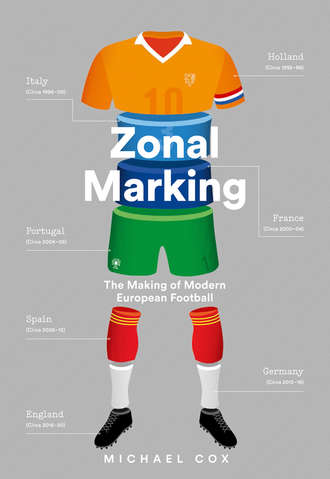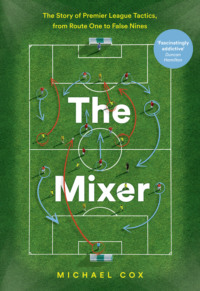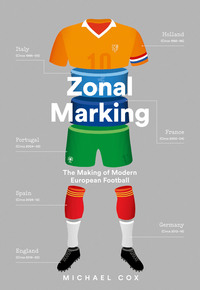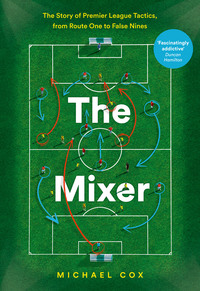
Полная версия
Zonal Marking
Lippi’s Juventus defined Italian football during this period. They became European and World champions in 1996, won Lo Scudetto in the next two campaigns, while reaching the Champions League Final in both years too, being beaten by Borussia Dortmund and Real Madrid in turn. Juve had long maintained a reputation for losing superstars yet continuing to prosper, sacrificing World Cup winners like Paolo Rossi and Marco Tardelli in the 1980s without suffering, while the players themselves declined after departing Turin. After the 1996 final it wasn’t just their defeated opponents Ajax who suffered because of the Bosman ruling; Juve lost Ravanelli and Vialli to newly monied Premier League clubs. Ravanelli had finished as Juventus’s top goalscorer that season, while Vialli had been named Player of the Year by World Soccer magazine, who commended him for being ‘equally at home on the right, the left or the centre of the attack – he defends like a tiger and attacks like a lion’. In other words, in keeping with the Juventus ethos, he could do whatever job Lippi demanded.
Juve still had Alessandro Del Piero, their golden boy, and replaced the outgoing duo with three players: Alen Bokšić, who led the line effectively but rarely scored; Christian Vieri, a complete striker who changed clubs every summer; and youngster Nicola Amoruso, who didn’t quite fulfil his potential, although his arrival was certainly appreciated by Del Piero, who married Amoruso’s sister. Veteran Michele Padovano was still around too, and proved a useful supersub.
Lippi therefore had five good options up front, and the nature of Juventus’s goalscoring throughout their 1996/97 title-winning campaign underlined how he used different strikers in different situations. Bizarrely, for champions, none of the five strikers recorded more than eight goals: half as many as Sandro Tovalieri, who played half the season for Reggiana and half for Cagliari, both of whom were relegated. Lippi had fully embraced rotation, and his five centre-forwards all played a similar amount: Bokšić scored just three goals from 51 per cent of Serie A minutes, an injury-affected Del Piero managed eight from 48 per cent, Vieri eight from 43 per cent, Padovano eight from 39 per cent and Amoruso four from 36 per cent. There was no grand hierarchy, no divide between untouchable first-teamers and frustrated back-ups, and everyone provided different qualities. Bokšić offered hold-up play, Del Piero provided invention, Vieri lent his aerial power, Padovano was a good poacher and Amoroso brought speed.
Significantly, Bokšić was the least prolific striker and yet also the most used, because he consistently worked hard and brought the best out of others. ‘No prima donnas, no privileges,’ declared Lippi. ‘If a player doesn’t agree with that, he can walk. You might like the antics and the eccentricities of a champion, but I believe people appreciate things like humility and intelligence.’ Lippi’s tendency to rotate forwards by using them tactically remained one of his trademarks throughout a long coaching career. When leading Italy to World Cup success in 2006, Lippi named six forwards in his 23-man squad: Francesco Totti, Pippo Inzaghi, Luca Toni, Alberto Gilardino, Vincenzo Iaquinta and his old favourite Del Piero. All six found themselves on the scoresheet.
When Ronaldo, the world’s most exciting striker, was destined to leave Barcelona and move to Serie A, Juventus declined to become involved in a bidding war, not because the sums of money were too vast, but because Umberto Agnelli, the club chairman, believed such an overt superstar would ruin the club’s spirit. Even Zinedine Zidane, who joined in 1996 and soon became Europe’s most celebrated player, was diligent, introverted and hard-working, a world away from the self-indulgent galáctico that he would later become at Real Madrid.
Zidane was shocked by the intensity of Juventus’s fitness sessions, led by the notorious Giampiero Ventrone. ‘Didier Deschamps told me about the training sessions but I didn’t believe they could be as bad as all that,’ he gasped. ‘Often I would be at the point of vomiting by the end, because I was so tired.’ Ventrone was nicknamed ‘The Marine’ by the Juventus players, and he had three terrifying mottos: ‘Work today to run tomorrow’; ‘Die but finish’; and ‘Victory belongs to the strong’. The players had a love–hate relationship with him; Ravanelli said he couldn’t cope without him, while Vialli once became so incensed by Ventrone’s approach that he locked him in a cupboard and called the police, not the last time the Carabinieri would take an interest in Juve’s methods of physical conditioning. It was Lippi, however, who remained Juventus’s most important asset. ‘He was like a light switch for me,’ Zidane said. ‘He switched me on and I understood what it meant to work for something that mattered. Before I arrived in Italy, football was a job, sure, but most of all it was about enjoying myself. After I arrived in Turin, the desire to win things took over.’
This is essentially what defines Italian football: the absolute primacy of winning. In other major footballing nations, to varying extents, emphasis is placed on the spectacle; attacking football is respected and sometimes considered an end in itself. But in Italy the result is paramount and the end justifies the means, which largely explains why Italian sides are content to win tactically rather than through finesse and panache. There’s certainly a reverence towards certain types of stylish player, particularly classy liberos and gifted trequartisti, but teams are under little pressure to provide dazzling collective performances like Ajax or Barcelona. Italian football therefore places huge emphasis on workmanlike players performing functional roles.
‘To Italian players, it’s a job. It’s not fun, not a game,’ said Fabio Capello. ‘When I was coaching Real Madrid, training would end and everyone would stay and eat, get a massage, go to the gym together … in Italy, they’ll stay as long as they have to, then they’ll go. We don’t have this joy inside us. It’s almost as if they don’t like being footballers.’ Capello was another celebrated Italian tactician, and his experience at Real Madrid during 1996/97 was particularly enlightening.
Capello had succeeded Arrigo Sacchi at Milan in 1992 and won four Serie A titles in five seasons, strung together an unprecedented 58-game unbeaten run and won the Champions League in 1994 with a memorable 4–0 thrashing of Barcelona. Capello was less ideologically attack-minded than the revolutionary Sacchi, but he provided creative players with more licence to express themselves, usually from wide roles in a 4–4–2. After Real Madrid slumped to sixth place in 1995/96, their worst season in nearly two decades, they turned to Capello. President Lorenzo Sanz declared him ‘the greatest manager in the world’ upon his appointment. Capello won the league in his first season. He then promptly returned to Italy.
While Capello brought success to the Bernabéu, that wasn’t enough for Real’s supporters and president, none of whom appreciated Real’s style – or lack of it – under Capello. While Barcelona showcased speed and trickery courtesy of Ronaldo’s legendary single season at the Camp Nou, Real were boring, functional and tactical; essentially, Capello had made them Italian. Raúl González, Spanish football’s new superstar forward, was asked to play from the left, with new signings Davor Šuker and Predrag Mijatović preferred up front. Real’s most common tactic involved centre-back Fernando Hierro launching long balls for overlapping left-back Roberto Carlos, a perfectly legitimate tactic that Real supporters nevertheless considered too direct, too brutal. Real insisted on inserting a clause in Capello’s contract that prevented him from joining Barcelona for three years after leaving Madrid, but if Real were so determined to compete with Barcelona in terms of attractive football, Capello heading for Catalonia would have helped redress the balance. ‘I believe the most important thing is to win,’ Capello once said. ‘Nothing else matters.’
‘In Spain, everything that comes from Italy is seen in a negative light,’ said defender José Amavisca, quoted in Gabriele Marcotti’s biography of Capello. ‘Because he’s Italian, everything Capello did was seen as ugly, dirty, nasty or boring.’ Capello’s training sessions were typically Italian: long periods spent drilling the back four into the correct shape, and a strong emphasis on hardcore fitness work. He spent much of the season squabbling with Sanz, the Real president, partly because Capello consistently refused to select his son Fernando, a graduate of the club’s academy. He also encountered problems with forwards Mijatović and Šuker, who were frequently substituted when Capello summoned defensive reinforcements. ‘My matches only ever last 75 minutes,’ complained Šuker. More than half of the Croatian’s La Liga starts ended with his withdrawal, a stark contrast to the star treatment Real Madrid forwards are usually afforded. His replacement was always a defender or defensive midfielder.
Capello was justified in sacrificing big names, because his tactical acumen was outstanding. During 1996/97 Real Madrid regularly started poorly and found themselves a goal behind, before Capello’s instructions enabled them to readjust and clinch victory. Real came from behind to win with incredible regularity: against Real Sociedad, Valencia, Atlético Madrid, Deportivo de La Coruña, Hércules, Racing Santander, Sevilla and Sporting Gijón.
The Sevilla comeback, in mid-April, was most significant. Capello started with his usual 4–4–2, with Raúl drifting inside from the left, but Real were absolutely battered by a rampant Sevilla, particularly down the flanks. Tarik Oulida, the Ajax-schooled left-winger, crossed for right-winger José Mari to head home in the first minute, then Oulida made it 2–0. Real could have easily been 4–0 down. Therefore, Capello made two tactical changes midway through the first half. Veteran defender Manuel Sanchís replaced beleaguered right-back Chendo. Next, Capello sacrificed Šuker and introduced defensive midfielder Zé Roberto. The home supporters were understandably bemused; at 2–0 down Real needed goals, and Capello had taken off a striker.
First, though, Capello knew Real required defensive solidity. Raúl pushed up front, Zé Roberto played on the left of a midfield diamond and screened Roberto Carlos. Real now coped down the flanks and could work their way into the game. On the stroke of half-time, Clarence Seedorf got a goal back, then Raúl scored the equaliser in the second half. Hierro headed home seven minutes from time, and then Seedorf teed up Mijatović. Real had been 2–0 down, Capello had made two first-half substitutions purely for tactical reasons, including substituting his top scorer, and they ended up winning 4–2.
Winning in this fashion would have been celebrated in Capello’s home country, but Real demanded more spectacular performances, and despite the title success, this was a loveless marriage that lasted just a year. Curiously, a decade later Capello returned for a second spell at the Bernabéu, with somewhat familiar consequences; he won the league, then he was sacked. ‘We have to find a coach who gives us a bit more,’ said Real’s sporting director, after Capello’s second departure. ‘We need a coach who, as well as getting results – which are very important – can help us enjoy our football again.’ The identity of the sporting director? Mijatović, the frequently substituted forward from Capello’s first stint. Two seasons, two titles, two acrimonious departures. Italian methods were not popular outside Italy.
But they were clearly conducive to success, because the three most respected Italian coaches of this era completed an extraordinary treble in 1996/97. Lippi triumphed in Serie A with Juventus, Capello was victorious in La Liga with Real Madrid, while Giovanni Trapattoni won the Bundesliga with Bayern Munich.
This was Trapattoni’s second spell with Bayern, after a disappointing 1994/95 campaign that he blamed on not mastering German properly, although upon his return his communication skills had only improved slightly. Trapattoni initially attempted to use a four-man defence, before reverting to the sweeper system that was more typically German, and indeed more typically Trapattoni, after some disappointing early results, including a 3–1 aggregate UEFA Cup defeat to Valencia. ‘Too many changes have upset their rhythm,’ claimed Trapattoni’s predecessor Otto Rehhagel after that European exit. ‘Bayern are paying for the mistakes in signing the wrong players and not sticking to a definite tactical system.’ Not sticking to a definite tactical system, though, was entirely Trapattoni’s plan.
His tactical tinkering continued to frustrate and caused problems among his key players. In late November Bayern were 2–0 up at half-time against relegation strugglers Hansa Rostock, so Trapattoni ordered his players to concentrate on keeping a clean sheet. But centre-forward Jürgen Klinsmann encouraged his teammates to continue attacking. The players were caught in two minds, conceded 20 minutes into the second half and limped to a 2–1 victory. ‘That’s why we lost our shape,’ complained left-wing-back Christian Ziege. ‘One defensive player would make a forward run, and everyone else would stay back and watch him disappear into the distance. Very confusing.’ But Trapattoni’s focus on tactical discipline, and his refusal to indulge FC Hollywood’s superstars, proved successful; compared with the previous campaign, Bayern only scored two more goals, but they conceded 12 fewer. ‘Under him, I learned how to defend,’ explained midfielder Mehmet Scholl. ‘But I also learned that if I played a bad pass, I would be substituted.’
Just like Capello in Madrid, Trapattoni’s substitutions proved particularly controversial in Munich, particularly with Klinsmann, who took a break from squabbling with long-time foe Lothar Matthäus to row with Trapattoni instead. Klinsmann knew exactly what to expect, having previously played under Trapattoni at Inter, but he frequently complained about the Italian’s defensive tactics and about being hauled off midway through the second half, generally so Trapattoni could introduce a defensive player. The final straw came three games from the end of the campaign, in a 0–0 home draw with Freiburg. Trapattoni summoned youngster Carsten Lakies for his first – and last – Bundesliga appearance, in place of Klinsmann, who screamed at Trapattoni on his way off, made an ‘It’s over’ hand gesture and then furiously booted a large, battery-shaped advertising hoarding, momentarily getting his foot stuck. ‘I was just trying to open the game up a bit,’ explained Trapattoni afterwards, gesturing as if he wanted more runs from wider positions.
The advertising hoarding later found its way into Bayern’s museum, a monument to Klinsmann’s rage and Trapattoni’s ultra-Italian tendency to sacrifice stars when tactically necessary. Bayern won the league and, after the celebratory parade, Trapattoni, in traditional Bavarian dress, treated Bayern’s supporters to some Italian songs from the balcony of Munich’s town hall. It was indeed over for Klinsmann after winning his only league title – he returned to Serie A, joining Sampdoria. ‘I wanted a club where the philosophy of football was right for me,’ he announced. ‘Sampdoria is that club and César Menotti is that sort of coach.’ It was a pointed dig at Trapattoni.
‘As an Italian coach in Germany, I was trying to change their mindset,’ remembered Trapattoni. ‘I was met with resistance, because you don’t change a mentality in two or three months. I wanted them to get accustomed to thinking tactically, developing the play and seeking options. I had to let them play their way and gradually blend in my tactics. After my first year, they began to change a little, but it was a cultural clash. In Germany, they follow a fixed plan. In Italy, we are more flexible.’
Trapattoni’s second campaign was less successful, and was most notable for his infamous press-conference rant in broken German, during which he screamed into the microphone, justifying his decision to omit Scholl, a classy playmaker, and Mario Basler, an unpredictable winger, neither of whom had been pulling their weight defensively. Trapattoni was keen to stress that Bayern played positive football in his diatribe. ‘No team in Germany plays attacking football like Bayern,’ he declared. ‘In the last game, on the pitch we had three strikers – Giovane Élber, Carsten Jancker and Alexander Zickler. We mustn’t forget Zickler! Zickler is a striker, more than Scholl, more than Basler!’ Even in this irritated state, Trapattoni felt compelled to underline that his selection wasn’t too defensive, too Italian.
In Italy itself, of course, no one had a problem with defensive football, and Lippi’s Juventus won the 1996/97 Serie A title in stereotypically unspectacular fashion. In their 34 matches they only scored the joint-fourth highest number of goals, but they conceded the fewest. They won fewer matches than second-placed Parma, but Parma lost four more. Juventus weren’t about scoring goals and winning matches, they were about not conceding goals, and therefore not losing matches.
Juve’s centre-back duo of Ciro Ferrara and Paolo Montero were hugely dominant, although both found themselves in trouble with referees. Montero was sent off away at Napoli and Cagliari, and both were suspended for the home contest with Milan in mid-November, a furiously contested game, delayed because of heavy downpour in Turin, with the touchlines needing to be repainted beforehand. Juventus, as ever, coped without key players, and the makeshift partnership of Sergio Porrini and Alessio Tacchinardi, a right-back and a central midfielder respectively, excelled against Roberto Baggio and George Weah. It finished goalless.
There were starring performances from Zidane, who recovered from a slow start to dominate Juve’s attacking play, and Del Piero, who suffered from injuries but also netted some crucial goals, including the winner in the Intercontinental Cup victory over River Plate. Lippi evolved his default system from the previous season, shifting from 4–3–3 to 4–4–2, which became 4–3–1–2 with Zidane shifting forward into the number 10 position. As always, Lippi used his functional players excellently. The wider midfielders, often Di Livio and Vladimir Jugović, played busy roles, tucking inside to support Didier Deschamps, who became Juve’s primary holding midfielder after Paulo Sousa’s move to Dortmund. Genuine width came from the left-back, usually Pessotto, and Juve shifted towards a three-man defence in possession with the right-back – Porrini or Torricelli – tucking inside, a trademark move from Italy’s old catenaccio system.
Lippi’s policy of switching full-backs, as witnessed in the Champions League Final against Ajax, was again used after 20 minutes in a 2–1 victory over Perugia in February. Porrini, playing as a right-sided centre-back alongside Ferrara, departed through injury but was replaced by Iuliano, who was left-footed and therefore played to the other side of Ferrara. Lippi decided Iuliano needed more protection, so switched Torricelli from right-back to left-back, and Pessotto made the opposite move. Again, only an Italian side would switch their full-backs so readily.
Lippi was never afraid to make early defensive changes, sacrificing Pessotto after 30 minutes against a rampant Udinese because he needed extra pace. Di Livio, a right-midfielder in the previous game, came on at left-back. Converting energetic right-sided midfielders into rampaging left-backs became something of a Lippi speciality; in a second stint with Juventus he did something similar with Gianluca Zambrotta, who became the world’s best in that position, and played both right-back and left-back under Lippi during the World Cup triumph in 2006.
Even when Lippi’s Juventus thrashed the opposition, they often did so efficiently rather than joyfully. In the 6–1 battering of PSG in the European Supercup first leg at a snowy Parc des Princes, Juve’s first four goals came from set-pieces. In fairness, they also defeated a shambolic Milan side by the same scoreline at San Siro in an incredibly dominant display, while the season’s most impressive victory was the 4–1 Champions League semi-final victory over familiar foes Ajax.
In the previous year’s final, Juventus were superior but only won after a shoot-out. This time they were rampant, underlining Italy’s dominance over Holland. Lippi, typically, sprung a tactical surprise in his 4–3–1–2 by using Ferrara and Iuliano, two centre-backs, in the full-back positions either side of Montero and Tacchinardi, forming a formidable, physically dominant defensive quartet. Up front, Juve pressed energetically, with Zidane joining Bokšić and Vieri in shutting down Danny Blind, Mario Melchiot and Frank de Boer. Ajax’s build-up play was disrupted and they uncharacteristically resorted to long balls, which played into the hands of Juve’s four centre-backs. Juventus, meanwhile, played direct football excellently, constantly launching the ball for Vieri and Bokšić, their strongest forward partnership, to batter Ajax’s defenders.
Zidane, meanwhile, ran the show. Supported by the positional discipline of Deschamps, and the energy of Di Livio and Attilio Lombardo – who switched flanks midway through the first half – the Frenchman was superb. In the first half he collected possession 40 yards from goal, advanced with the ball then slowed his dribble, before jinking past three challenges towards the left flank. He then crossed for Vieri, whose shot was deflected wide. Zidane swung in the corner, and Lombardo headed home. The Frenchman was involved in the build-up to the second, scored by Vieri. For the third, Zidane’s speed allowed him to intercept the ball in midfield and he launched a counter-attack, wrongfooted Danny Blind with a stepover and allowed substitute Amoroso to tap into an empty goal. Zidane scored the fourth himself, receiving a pass from Didier Deschamps and faking a shot to leave Edwin van der Sar on the ground, before finishing into an open goal. ‘He is, without a doubt, the greatest player I ever coached,’ said Lippi. ‘And I also think he’s the greatest player of the next 20 years. The previous 20 it was Maradona, and the next twenty, Zidane. I am convinced of that.’
The Ajax victory was arguably Juventus’s greatest under Lippi, and highlighted the three areas in which Italian football had an advantage over Dutch football: tactical flexibility, physical power and a standout individual performance from a world-class talent. ‘Zidane was different class, even in such a remarkable team,’ declared a defeated Louis van Gaal. ‘They are a great team with great skills, a pleasure to watch. I’ll repeat what I said after the first leg: I have never met opponents who beat us like Juventus did.’
Juve were surprisingly defeated 3–1 in the final by Dortmund, who were better prepared for Juventus’s physicality and nullified Zidane through Paul Lambert’s excellent marking. Yet the game could have been very different; Juventus created the better chances, twice hit the woodwork and Bokšić had a goal controversially disallowed. After Juve found themselves 2–0 down at half-time, they switched from 4–3–1–2 to 4–3–3, with Del Piero on for Di Livio. This forced Dortmund to retreat, and Del Piero’s backheeled goal from Bokšić’s cross seemed set to launch a comeback. Soon afterwards, however, 20-year-old Dortmund youth product Lars Ricken was summoned in place of Stéphane Chapuisat, and took all of 16 seconds to make it 3–1, scoring with his first touch after streaking away on a counter-attack and producing a remarkable long-range shot that curled around Angelo Peruzzi. It was a shock win. ‘Having watched that final as a spectator, the only sentiment I have is anger,’ said the injured Conte. ‘Because the weaker side won, and because there’s nothing you can do to set it straight – nothing except turn out again in next season’s Champions League, and win it.’
1997/98 marked a shift in Lippi’s approach up front. Vieri had departed for Atlético Madrid, and the arrival of Pippo Inzaghi, Italian football’s brightest young goalscorer, meant Juventus now had a solid first-choice centre-forward. Lippi rotated less, and there was more combination play between the front three. ‘Now, we have to keep the ball on the ground, rather than trying to knock it onto Vieri’s head as we did last season,’ explained Del Piero. Zidane, Del Piero and Inzaghi were largely allowed freedom from defensive responsibilities, and there was a clear split in Juventus’s system: the back seven players were functional, the forward trio were allowed freedom to express themselves. ‘This time, we have the best defence and the best attack,’ bragged Lippi.








